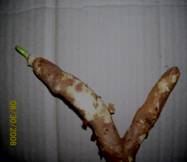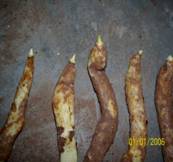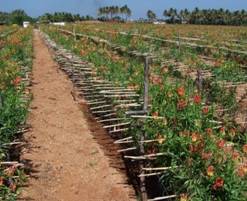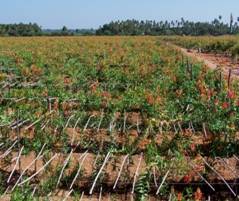Economic part - Seed
Major constituents - Colchicine (0.5-0.7%) and Colchicoside
Uses - cures gout, anti inflammatory, anticancer
Varieties
No released varieties are found. Singaleri selection possesses 0.25 % Colchicine.
Soil and climate
Well drained red loamy soils are suited for cultivation. The ideal pH should be 6.0 – 7.0. This can be cultivated up to 600 m from mean sea level with an annual rainfall of 70 cm. Glory lily is cultivated in Tamil Nadu mainly in the western parts viz., Mulanur, Dharapuram of Tirupur district, Oddanchatram and Ambilikai of Dindigul district, Markampatty and Aravakurichi of Karur District, Attur, Jeyankondam of Salem district in an area of 2000 ha. |
 |
 |
| Sprouted tuber for planting |
|
Seed and seed rate
Gloriosa is propagated through tubers. 2000 kg tubers are required for planting one hectare. Tubers are treated with 0.1 % Carbendazim for half an hour for controlling tuber rot.
Season
Planting is distributed from June – July
Planting
Field is ploughed 2 -3 times and incorporate 10 tonnes of FYM during last ploughing. Trenches of 30 cm depth are formed and tubers are planted at 30 – 45 cm spacing. The vines are trained over support plants (Commiphora beryii, Dedonea viscose). Permanent structures with G.I. wires can also be formed for growing the vines.
 |
 |
 |
| Land preparation |
Field view |
Irrigation
Irrigation is given immediately after planting. Subsequently irrigation is given at 5 days intervals of time.
Manuring
NPK at 120:50:75 kg/ha is applied in two split doses. Half of N and the entire P and K are applied as basal dressing. Remaining quantity of N is applied at one and two month after planting.
After cultivation
Commiphora must be trimmed annually. Care must be taken to avoid the damages to growing portions. Artificial pollination can be done between 8 – 11 am for getting higher yield.
|



